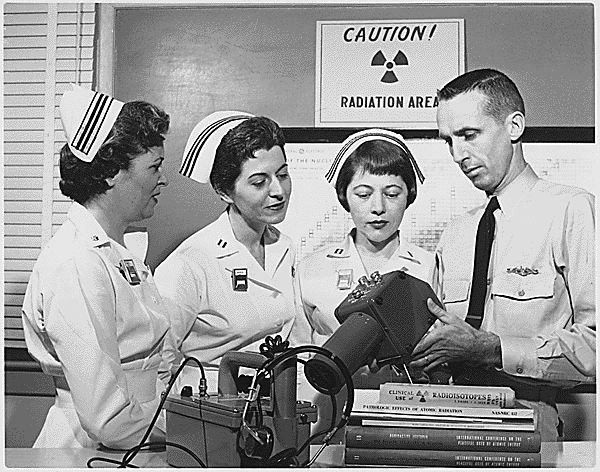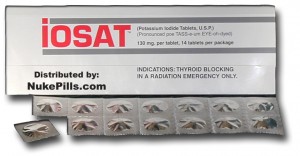
Last week, my neighborhood health food store ran out of potassium iodide, a compound that can prevent thyroid cancer in people exposed to high doses of radiation. When I called the store, an employee told me demand has been high “ever since the incident in Japan.” I live in Brooklyn, New York, nearly 7,000 miles away from the damaged Fukushima nuclear plant. So what my neighbors plan to do with their potassium iodide is a total mystery. (FYI, if you try to use Google maps to determine the distance from Brooklyn to Fukushima, you will be directed to “kayak across the Pacific Ocean.” No joke.)
 Although radioactive isotopes from Japan have been detected in roughly a dozen states the US (New York is not one of them), the levels are low. On Sunday, after rainwater in Massachusetts and Pennsylvania showed elevated levels of radioactive material, the CDC, FDA, and EPA issued a joint statement, noting that the levels detected “are 25 times below the level that would be of concern for use as a sole source of water over a short period of time even for infants, pregnant women or breastfeeding women, who are the most sensitive to radiation.” They added, “At this time, there continues to be no indication for anyone in the United States to take potassium iodine or switch to bottled water on the basis of the events in Japan.”
Although radioactive isotopes from Japan have been detected in roughly a dozen states the US (New York is not one of them), the levels are low. On Sunday, after rainwater in Massachusetts and Pennsylvania showed elevated levels of radioactive material, the CDC, FDA, and EPA issued a joint statement, noting that the levels detected “are 25 times below the level that would be of concern for use as a sole source of water over a short period of time even for infants, pregnant women or breastfeeding women, who are the most sensitive to radiation.” They added, “At this time, there continues to be no indication for anyone in the United States to take potassium iodine or switch to bottled water on the basis of the events in Japan.”
Taking potassium iodide can be risky. A joint statement from several professional organizations including The Endocrine Society and the Society of Nuclear Medicine warned that potassium iodide “can cause allergic reactions, skin rashes, salivary gland inflammation, hyperthyroidism or hypothyroidism in a small percentage of people.” Leonard Wartofsky, a thyroid expert and chairman of the Department of Medicine at Washington Hospital Center in DC, said in an msnbc.com article, “It is inappropriate, foolhardy and dangerous to be taking iodine supplements at this time.” Hear that, Brooklyn? I didn’t think so.
So why the disconnect between what scientists are telling people to do and what people are actually doing? Could the message be getting scrambled? Are journalists not doing their jobs? I don’t think so. The articles I read clearly stated that radiation levels in the US are too low to warrant taking the pills. The public, for whatever reason, just isn’t listening.
Risk is a notoriously tricky thing to communicate, especially when the audience is children. In the video below, Japanese artist Kazuhiko Hachiya takes a stab at explaining the dangers of radiation using poop and farts. I’m not sure he succeeds, but the video has gone viral. Rumor has it this is playing on national TV in Japan. Watch and be amazed.
**
Image of the nurses courtesy of the Department of Defense. Department of the Navy. Naval Photographic Center.
Image of potassium iodide courtesy of nukepills.com
Thank you for the post. I am stunned by the video. Who in the world came up with such a trivializing metaphor for nuclear disaster? Poops and farts? Denial is a powerful tool.
But is there any indication that people are actually *taking* the iodine? It’s entirely possible that they are simply hoarding it due to fears of nuclear events in the US, or they may be intending to attempt to send iodine to friends/family in Japan.
Given the way we tend to “plan” for disasters only after we’ve just seen one, I’m inclined to believe most of that iodine is sitting on shelves next to freshly purchased emergency supplies that will end up getting thrown away and not replenished until after the next disaster.
evanstonian, I agree that the video is stunning, but I don’t think Kazuhiko Hachiya, the artist who created it, was trying to trivialize the nuclear disaster in Japan. He wanted to find a way of explaining the situation to little kids. I think the execution leaves something to be desired, but his heart was in the right place.
Jennifer, I definitely don’t have any proof that people in Brooklyn are taking potassium iodide, but that msnbc.com article that I cite says poison control centers have been getting calls. So people somewhere in the US are taking the pills, getting sick, and then calling poison control centers.
I don’t think much of the art itself, but I think you’re right that he was trying to explain it to kids.
Nonetheless I have to agree with evanstonian–when I got to the part about 3 Mile Island, I cringed preemptively, wondering how Chernobyl would be portrayed. And sure enough: flying diarrhea (oh sorry, spoiler alert).
Various cultures have differing opinions on what’s funny, offensive, appropriate/not, etc. There are two well-known Japanese books for toddlers — “Everybody Poops” and “Everybody Farts” — that are popular (in translation) in the US because they’re so straightforward, kids love them! The Japanese, for all their refinement, just don’t seem to have the squeamishness we do over these bodily functions.
I’m sure the video is an authentic effort. As odd as these metaphors seem to us, Japanese children probably don’t find them strange and probably find poop less frightening than, say, poison.